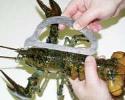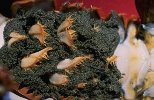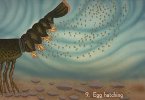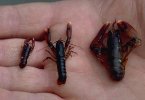American Lobsters live in the Atlantic Ocean. They live on the ocean floor and are found from Canada to North Carolina. They make cave like homes under rocks, in seaweed, or in the sand.
Did you know that lobsters are related to insects? Well its true, insects and lobsters, as well as spiders and tick, are grouped together by scientists into a group called arthropod, because they all share ancestors, body structures and behaviors. Lobsters, like insects, have their bones on the outside of their body, these bones are collectively called an exo-skeleton or shell. Lobsters also have antennae, like insects, which they use to sniff out food and feel around in their environment. Lobsters can't see very well so they use their antennae to help them get around. Lobsters use their claws to grab food and other things. They have a large claw, called a crusher, to crush their food and a smaller claw, called a pincer, that they use to tear apart their food and bring it to their mouth.


When a lobster is caught in a trap, the lobsterman bands the claws to keep them shut.
Lobstermen and women fish for lobsters using traps, sometimes called pots. They bait the traps with smelly fish to attract the lobsters. When a lobsterman pulls his trap out of the ocean he doesn't keep all the lobsters inside. Instead he uses a gauge, which is a type of ruler, to measure each lobster, and he only keeps the medium sized lobsters. He returns the small and large lobsters back into the ocean. He also returns to the ocean the pregant female lobsters, these lobsters, called eggers, carry their eggs around on the bottom of their tail until the eggs hatch into baby lobsters. By throwing back into the ocean some lobsters, lobstermen are helping to make sure that the lobster population stays healthy.


A gauge is used to measure lobsters. Those that are too small or too large and those with eggs, like the lobster in the picture, are returned to the ocean.
When lobster eggs are ready to hatch, the mother whips her tail and shakes the baby lobsters into the water. Baby lobsters or larval lobsters are very, very small when they first hatch and best seen with a microscope. When they first hatch their bodies are shaped differently than adult lobsters and they live up in the ocean's water current, not on the ocean floor (like adult lobsters). lav lobsters float at the top of the ocean with other small plants and animals, which are collectively called plankton. As a lobster grows or molts, its body shape changes (just like when a tadpole grows into a frog). Eventually, the baby lobster looks just like an adult lobster, just smaller. At this time the lobster sinks to the ocean floor and finds a home among the rocks and seaweed.


When the eggs are fully grown the mother lobster shakes her tail and the larval lobsters float up into the water. Baby lobsters are very small, the lobsters in this picture have already molted at least 5 times and now live on the ocean floor.
